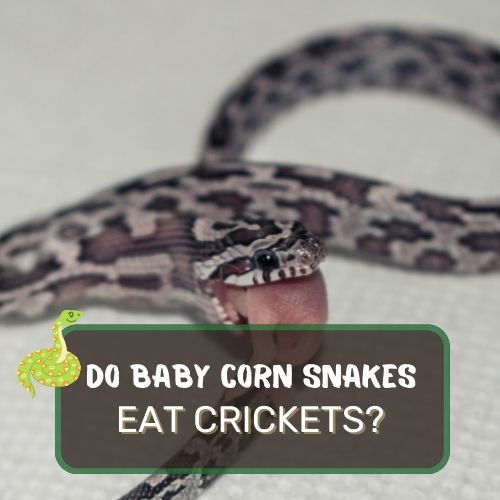
When it comes to the intriguing question, “Do baby corn snakes eat crickets?”, many reptile enthusiasts and potential snake owners find themselves scratching their heads.
Corn snakes, with their captivating patterns and gentle nature, are a popular choice among pet lovers.
But understanding their dietary preferences is crucial for their well-being.
In this article, we delve deep into the dietary habits of baby corn snakes, exploring their natural inclinations and the role crickets might play in their diet.
By examining factors like the snake’s heat-sensitive hunting methods and the nutritional value of crickets, we aim to provide a comprehensive answer.
Read on to discover the fascinating world of corn snake diets and ensure your slithery friend gets the best care possible!
Table of Contents
Do Baby Corn Snakes Eat Crickets? (Not Really)
No, baby corn snakes typically do not eat crickets. Their primary diet consists of small rodents, especially pinkie mice. While crickets are a common food source for many reptiles, corn snakes, both young and adult, have a natural inclination towards warm-blooded prey. This preference is due to their ability to detect the body heat of their prey, making warm-blooded rodents more appealing. Crickets, being cold-blooded, don’t emit the same heat signals, making them less enticing to corn snakes. Therefore, while crickets might be nutritious, they aren’t the go-to food choice for baby corn snakes.
Natural Diet of Corn Snakes
Corn snakes, with their vibrant colors and docile nature, are a favorite among reptile enthusiasts. But what do these slithering beauties munch on? Let’s dive deep into their dietary preferences.
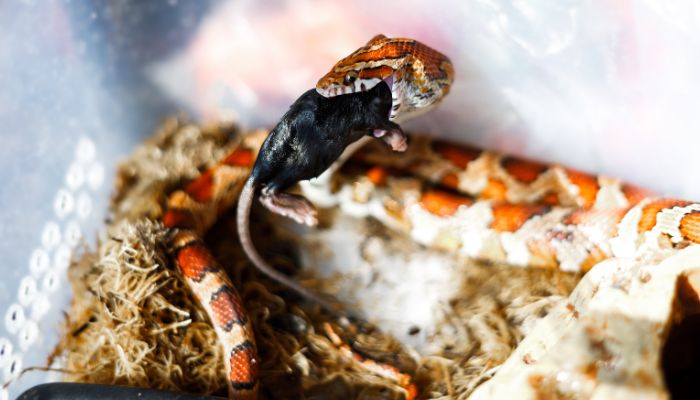
Corn snakes’ preference for rodents like mice.
Imagine being a corn snake, slithering through the grass, your senses tingling, and then you sense it – the tiny heartbeat of a mouse. Rodents, especially mice, are like the chocolate chip cookies of the corn snake world.
They can’t resist them! In the wild, these snakes have honed their hunting skills to perfection, making mice their primary prey.
The reason?
Mice offer a balanced meal of protein, fat, and other essential nutrients that keep our scaly friends healthy and active.
The convenience of feeding frozen mice to pet corn snakes.
Now, if you’re a corn snake owner, you might be thinking, “Do I need to let mice run around my house to feed my snake?” Thankfully, no! The pet industry has made it super convenient for snake owners.
Frozen mice, available at most pet stores, are a safe and easy way to ensure your corn snake gets its favorite meal without the hassle of live prey. Just thaw, serve, and watch your snake enjoy its gourmet meal!
Other potential foods: lizards, eggs, and poultry.
While mice are the main course, corn snakes, being the opportunistic feeders they are, occasionally indulge in other delicacies. Lizards, for instance, can be a tasty treat, especially for those snakes living in areas rich in reptilian life.
Eggs? Oh, they’re like the Sunday brunch for corn snakes. And let’s not forget small poultry. A chick might occasionally find its way into a corn snake’s diet, providing a change from the usual rodent fare.
Can Corn Snakes Eat Crickets?
The short answer? Not really. While crickets are a popular food for many reptiles, corn snakes don’t typically have them on their menu. It’s like offering a steak lover a salad. They might nibble on it, but it’s not their first choice.
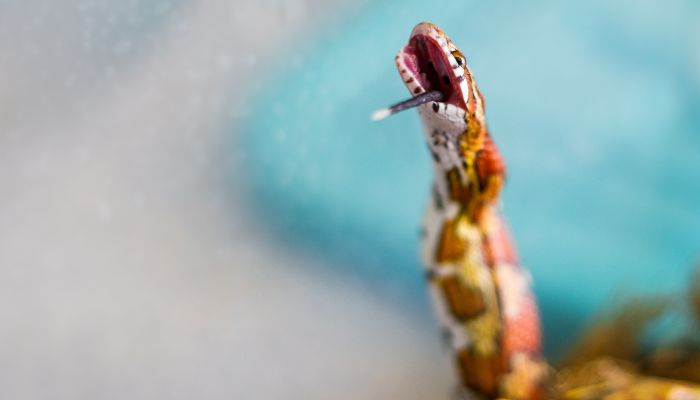
Why corn snakes don’t usually eat crickets?
Now, you might wonder, “Why the aversion to crickets?” Well, it’s all about the heat. Corn snakes, like many reptiles, have an incredible ability to detect the body heat of their prey.
This heat detection plays a crucial role in their hunting strategy.
Mice and other warm-blooded animals give off a lot more heat than cold-blooded crickets. So, to a corn snake, a cricket is like a stealthy ninja, hard to detect and not worth the effort.
The role of body heat in a snake’s prey detection.
Let’s dive a bit deeper into this heat detection superpower. Corn snakes have specialized pits near their nostrils that can sense the infrared radiation (or body heat) emitted by their prey. It’s like having built-in night vision goggles!
This ability allows them to hunt efficiently, even in low light conditions. So, when a warm, juicy mouse scurries by, it’s like a beacon of deliciousness to the snake. A cricket, on the other hand, barely registers on their heat radar.
While crickets might be a staple for many reptiles, for corn snakes, they’re more of an afterthought. These snakes have evolved over millennia to prefer warm-blooded prey, making rodents their meal of choice.
So, if you’re thinking of getting a corn snake, stock up on those frozen mice, and maybe, just maybe, throw in an occasional lizard or egg for good measure!
Why Corn Snakes Might Not Eat Crickets
Corn snakes, with their mesmerizing patterns and gentle demeanor, have a particular way of choosing their meals.
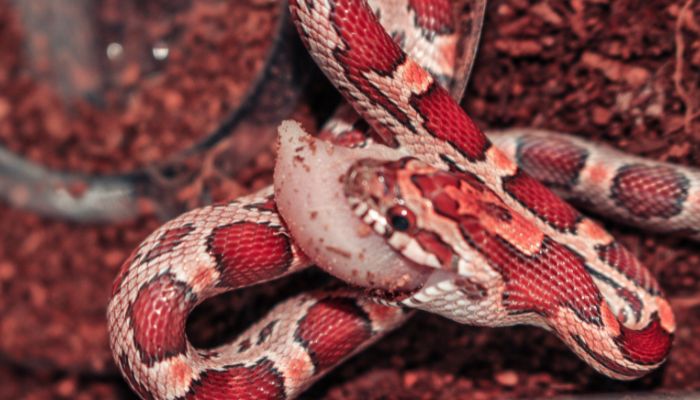
And while crickets might seem like a logical choice for a reptile, these snakes have their reasons for usually bypassing the insect aisle.
Insects’ low body heat making them less detectable to snakes.
Imagine you’re at a party, and there’s a faint aroma of your favorite dish. You’d naturally gravitate towards it, right? For corn snakes, that favorite dish is usually a warm-blooded creature.
Insects, including crickets, are cold-blooded, meaning they don’t emit much body heat. To a corn snake’s heat-sensitive pits, a cricket is almost invisible, making it a less enticing meal option.
Snakes’ reliance on body heat to hunt their prey.
Corn snakes are equipped with a fantastic adaptation: infrared-sensitive receptors. These receptors allow them to detect the body heat of potential prey. It’s like having a built-in thermal camera!
This ability is especially handy when hunting in the dark or in tall grasses. Warm-blooded animals, like rodents, stand out like a beacon, making them an easy target. Crickets, with their minimal body heat, don’t offer the same advantage.
The preference for warm-blooded mammals like rodents.
Evolution has fine-tuned the corn snake’s diet. Over millennia, these snakes have developed a palate that heavily favors rodents. Why? Rodents are not only easier to detect but also pack a nutritional punch.
They provide the right balance of protein, fat, and other essential nutrients that a growing corn snake needs. Crickets, while nutritious, don’t offer the same caloric density, making them a less satisfying meal.
Benefits and Drawbacks of Feeding Crickets
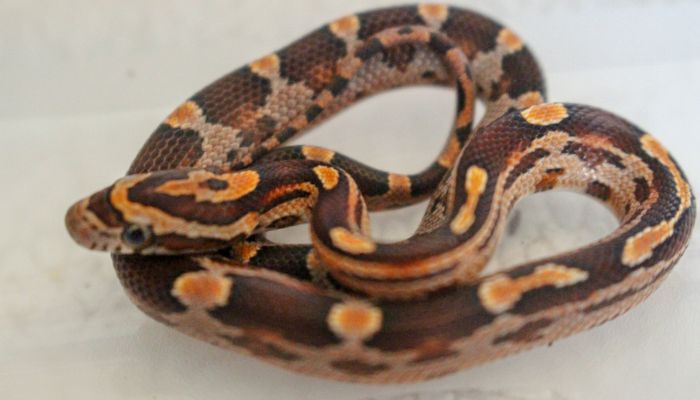
Alright, let’s play devil’s advocate for a moment. Suppose you still want to consider crickets as a potential food source for your corn snake. What are the pros and cons?
Nutritional value of crickets.
Crickets are no junk food. They’re packed with protein, essential amino acids, and vitamins. For many reptiles, they’re a dietary staple. They can offer variety and stimulate hunting instincts, especially when offered live.
Potential risks: parasites, hard exoskeleton, and stress.
However, crickets come with their baggage. They can be carriers of parasites, which can harm your snake. Their hard exoskeleton, known as chitin, can be challenging for snakes to digest.
And if you’ve ever seen a cricket jump around, you’ll know they can be quite active. For a snake, this can be stressful, especially if the cricket decides to bite or jump around in the enclosure.
Alternatives for a well-balanced diet.
If you’re looking to diversify your corn snake’s diet, there are safer and more nutritious alternatives. Rodents, as we’ve established, are the gold standard. But you can also consider occasional treats like small birds or fish.
And if you’re keen on insects, consider softer-bodied ones like mealworms or waxworms, which are easier to digest and less active than crickets.
While crickets might seem like a convenient food option, they’re not the best choice for corn snakes. Stick to the tried and tested rodents, and your slithery friend will thank you with good health and vibrant colors!
Considerations Before Feeding Crickets
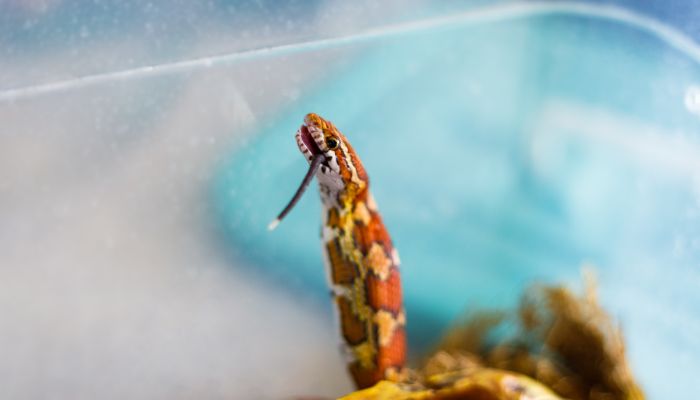
So, you’re still contemplating the cricket route for your corn snake? No worries! But before you jump in, there are a few things you should consider to ensure the safety and well-being of your scaly companion.
Proper size and preparation of crickets.
Size matters, especially when it comes to feeding reptiles. Offering crickets that are too large can pose a choking hazard. As a rule of thumb, the cricket should be no larger than the width of your snake’s head.
Also, consider gut-loading the crickets before feeding. This means feeding the crickets a nutritious diet before offering them to your snake, ensuring they pass on those nutrients.
Monitoring the snake’s reaction.
Every snake is an individual with its own preferences. If you decide to offer crickets, pay close attention to your snake’s reaction. Does it show interest? Does it eat the cricket, or does it seem stressed or disinterested?
Observing these behaviors can give you insights into whether crickets are a suitable food option.
Consulting with a veterinarian or reptile expert.
When in doubt, ask the experts! A veterinarian specializing in reptiles or a seasoned reptile keeper can offer guidance. They can provide insights into the suitability of crickets as a food source and offer alternative feeding suggestions.
FAQ
Caring for baby corn snakes can be a delightful experience, but it also comes with a myriad of questions, especially when it comes to their diet. Let’s dive into some of the most common queries to ensure your little reptilian friend gets the best care.
What else can baby corn snakes eat?
While pinkie mice are the go-to meal for baby corn snakes, these curious creatures can sometimes show interest in other foods. In the wild, they might come across small amphibians, tiny lizards, or even bird hatchlings. However, in captivity, it’s best to stick to a diet that mirrors their natural preferences. If you’re feeling adventurous, you could occasionally offer a small lizard, but always ensure it’s safe and free from any potential toxins.
Do baby corn snakes eat worms?
It’s a common question, given that many reptiles relish worms. However, baby corn snakes typically aren’t fans. Their evolutionary diet leans more towards vertebrates like rodents. So, while a worm might be tempting to offer, it’s likely your baby corn snake will turn up its nose at it.
How often do you feed a baby corn snake?
Baby corn snakes are growing machines! To support their rapid development, it’s advisable to feed them every 5-7 days. This frequency ensures they get the nutrients they need to grow strong and healthy. As they mature, you can adjust the feeding schedule based on their needs and size.
How long can a small corn snake go without eating?
These resilient reptiles can go without food for a surprisingly long time. However, for baby corn snakes, consistent meals are crucial for their growth and well-being. If you notice your baby corn snake refusing food for more than two weeks, it’s time to raise a red flag. Check their environment, ensure the temperature and humidity are optimal, and consider consulting a reptile expert or veterinarian.
Conclusion
You’ve journeyed through the culinary world of baby corn snakes, and what a wild ride it’s been! Who knew these slithery little fashionistas were so picky about their dinner?
While you might be munching on your chips and thinking crickets could be the next big snack (for snakes, not you!), our baby corn snake friends beg to differ.
They’d much rather have a juicy mouse over a crunchy cricket any day. It’s all about that warm-blooded allure, you see. But hey, to each their own, right?
Remember, understanding your pet’s dietary needs is a bit like knowing your friend’s favorite pizza toppings. It just makes hangouts (or feedings) smoother.
So, hats off to you for diving deep into the dietary dossier of corn snakes. Keep that curiosity burning, and always be ready to learn and adapt.
After all, whether it’s pizza or pinkie mice, it’s all about finding what makes our bellies (or terrariums) happy. Here’s to many more feeding adventures and happy, well-fed corn snakes!

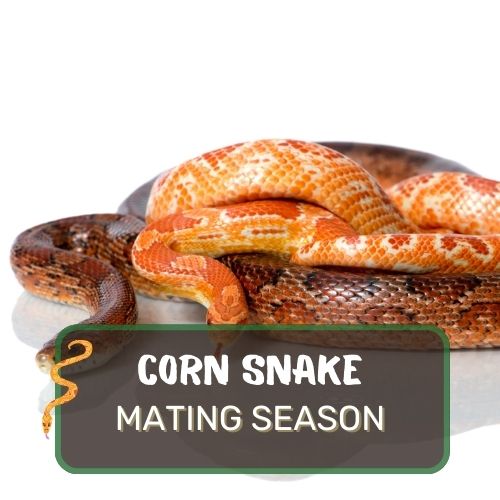
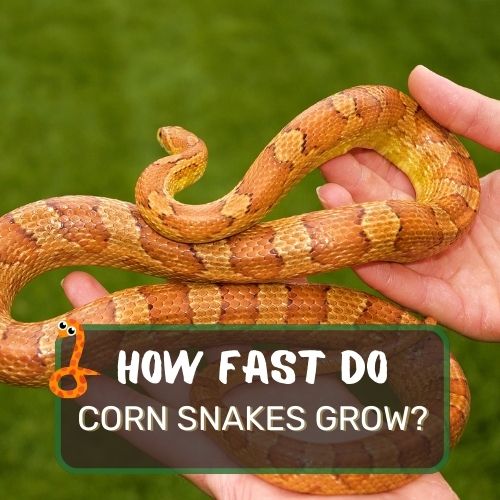
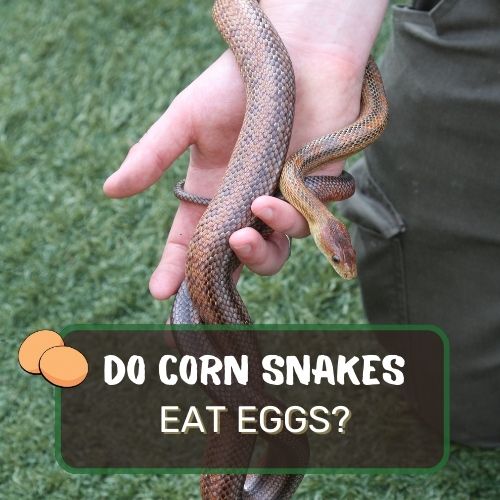
0 Comments